

Most Awaited Technological Devices of 2013. EmailShare 2013 has a lot in store as far as technology is concerned.
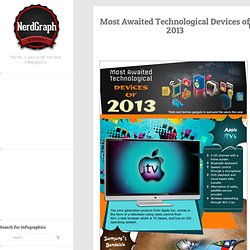
A lot of big names are expected to launch their new range of products. It will be interesting to see as to which technology will achieve the maximum popularity from the user’s end. Surely, the year will turn out to be a revolutionary year in the ever blooming techno arena. Via: visual.ly. Elearning trends feb12. טוויטר ככלי ללמידה.wmv Custom E-Learning Training & LMS Solutions Kineo. 5 Top Augmented Reality Apps for Education. The concept of augmented reality has been in existence for a few years now despite the fact that many users of mobile devices are under the impression that it is a new phenomenon.
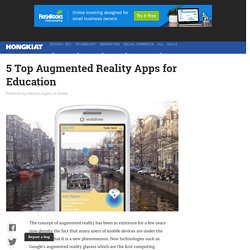
New technologies such as Google’s augmented reality glasses which are the first computing eyewear are still in the testing phase. This leads mobile device users to believe augmented reality is new on the horizon. Pin it Even though Google Glasses have yet to be officially released, there are hundreds of augmented reality apps that you can get for your smartphone which work just as well. These apps can be used in everyday applications and even more so for educational purposes. 1. This is an augmented reality app which makes learning about astronomy interesting and fun. 8 Excellent Augmented Reality Apps for iPad. In this post Educational Technology and Mobile Learning is providing you with a list of some awesome augmented reality apps for your iPad but before that let us first see what the concept of augmented reality is all about .

Augmented reality is a relatively new digital phenomenon that is brought about by the recent development in the field of technology and particularly mobile technology. In augmented reality the line between the virtual world and the real one is blurred. Engineers use some sophisticated technologies to pull out graphics from television screen and computer display and integrate them into real world environments. ELI7090. Stanford Mobile Inquiry-based Learning Environment (SMILE)
The Stanford Mobile Inquiry-based Learning Environment (SMILE) enables students to quickly pose multimedia-rich multiple-choice questions and share them with peers using mobile phones during class.
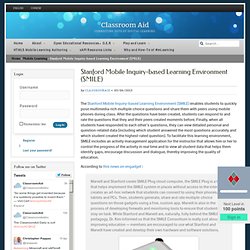
After the questions have been created, students can respond to and rate the questions that they and their peers created moments before. Finally, when all students have responded to each other’s questions, they can view detailed personal and question-related data (including which student answered the most questions accurately and which student created the highest-rated question). To facilitate this learning environment, SMILE includes an activity management application for the instructor that allows him or her to control the progress of the activity in real time and to view all student data that helps them identify gaps, encourage discussion and dialogue, thereby improving the quality of education. According to this news on engadget : Related article: The Knowledge Guru.
Advanced Distributed Learning. Synopsis Mobile learning is a new educational technology and introduces both exciting capabilities and complexity into the learning design process, but with very few guidelines.
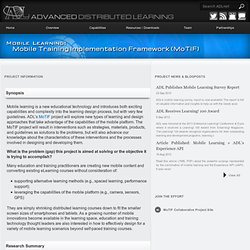
ADL’s MoTIF project will explore new types of learning and design approaches that take advantage of the capabilities of the mobile platform. The MoTIF project will result in interventions such as strategies, materials, products, and guidelines as solutions to the problems, but will also advance our knowledge about the characteristics of these interventions and the processes involved in designing and developing them. What is the problem (gap) this project is aimed at solving or the objective it is trying to accomplish? HOW TO: Convert Videos for Your iPhone (or Any Mobile Device) Video on devices like the iPod, iTouch and iPhone look great because of their MPEG-4 H.264 format.
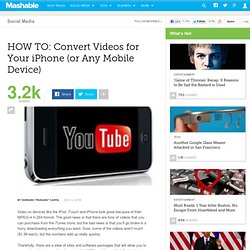
The good news is that there are tons of videos that you can purchase from the iTunes store, but the bad news is that you'll go broke in a hurry downloading everything you want. Sure, some of the videos aren't much ($1.99 each), but the numbers add up really quickly. Thankfully, there are a slew of sites and software packages that will allow you to convert just about any video format to the H.264 mp4 format that Apple devices require. Here are the best solutions for converting videos online as well as off. Some will convert any video you have on your local computer while others will only convert videos that you find online.
Sites & Software ConvertTube is a free service that converts online videos to several formats including the MP4 format that you need for Apple devices. VideoDownloader is similar to ConvertTube except it doesn't provide you with any output options. Screen Recording and Screencasting Software - ScreenFlow Overview - Telestream. Highest Quality Recording ScreenFlow has the best screen recording available – whether you are recording multiple screens at once, or using retina displays.

Built in Stock Media Library Spice up your videos with access to over 500,000 unique images, audio & video clips and more directly from within your ScreenFlow projects. iOS Recording Record your iPhone or iPad screen for high quality app demos. Easy to Learn, Easy to Use ScreenFlow’s intuitive UI allows everyone to create amazing content in minutes. Powerful Video Editing Tools. Five Tips for Creating Graphics for Mobile DevicesThe Upside Learning Blog.
Caption, translate, subtitle and transcribe video. Video Hosting for Business. Mobile Instructional Design Principles for Adult Learners. Applied Research Connect with AIM Feedback Do you have a question or comment?

We would love to hear from you. Get in touch. Pictured Above. iPad_App_and_Website_Usability_2nd_Edition. Instructional Design for Mobile Learning. What is a connectivist MOOC? “MOOCs” are massive open online courses.
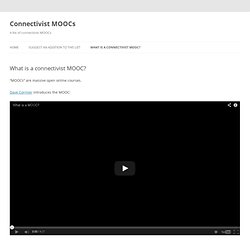
Dave Cormier introduces the MOOC: There’s a great written explanation of MOOCs in the introduction to the PLENK2010 MOOC Stephen Downes explains: This longer interview with George Siemens and Howard Rheingold is also a very helpful introduction to connectivism: August 2012′s MOOCMOOC was a one-week course led by Hybrid Pedagogy which examined the MOOC medium. As a springboard for more on MOOCs, check out the readings from Sunday and Monday and have a look at this piece on the MOOC Misnomer which does a nice job of dismantling lazy use of the term. Three Kinds of MOOCs. By Lisa, on August 15th, 2012 We are so into MOOCs now that it’s too much for me.
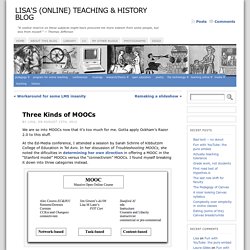
Gotta apply Ockham’s Razor 2.0 to this stuff. At the Ed-Media conference, I attended a session by Sarah Schrire of Kibbutzim College of Education in Tel Aviv. In her discussion of Troubleshooting MOOCs, she noted the dificulties in determining her own direction in offering a MOOC in the “Stanford model” MOOCs versus the “connectivism” MOOCs. I found myself breaking it down into three categories instead. Each type of MOOC has all three elements (networks, tasks and content), but each has a goal that is dominant. Network-based MOOCs are the original MOOCs, taught by Alec Couros, George Siemens, Stephen Downes, Dave Cormier. Task-based MOOCs emphasize skills in the sense that they ask the learner to complete certain types of work.
Content-based MOOCs are the ones with huge enrollments, commercial prospects, big university professors, automated testing, and exposure in the popular press. Your Online Self: Preparing for a Connectivist MOOC - home. 20 Educational iPhone Apps for Everyday Uses. Smartphone and Mobile App Usage - Infographic. Float-Mobile-Learning-Through-the-Years.jpg (JPEG Image, 612 × 1548 pixels) - Scaled (42%)
Mobile Learning: What is that? Mobile Learning infoKit. Mobile Learning Guide Part 1: Designing it right. Mobile Learning - Four R’s Model and Mobile Learning Activities. Repost of posting to EdNa forums, with other commentary here. A summary of previous theorisings on this model, here and here, supplemented with diagrams. We can classify mobile learning activities using an activity-based model of the “Four R’s of Mobile Learning”.
In a reflection of the “Three R’s” of the essential pre-Net Generation skills (Reading, wRiting, and aRithmetic), the “Four R’s” of Net Generation learning reflect the current sociocultural shifts in thinking and learning for an increasingly mobile twenty-first century. Defined from a learner-centric viewpoint, these are: Record : The learner as a gatherer and “builder” of new knowledge Reinterpret: The learner as an analyst of existing data to discover new knowledge. Basics - Mobile Learning Handbook. Student Polling/Audience Response Systems This topic deserves a special section because its use is becoming more common, and the use cases can be compelling for instructors of synchronous learning experiences. This mobile device application involves presenting a question to students through their learning medium (e.g., PowerPoint slides in a classroom).
Students are asked by the instructor to send a text message to a designated address, with key codes corresponding to poll answer choices. The results are displayed immediately on the learning medium. This can be used by the instructor during a class to assess whether students understand a concept, to characterize the demographics of his/her audience in order to fine tune the delivery, or just to gauge how prevalent certain (possibly erroneous) assumptions or motivations are about the content in advance. Teachingwithemergingtech. Mobile Learning Resources - Differences between Mobile Learning and eLearning.
Mobile Devices in Teaching and Learning.